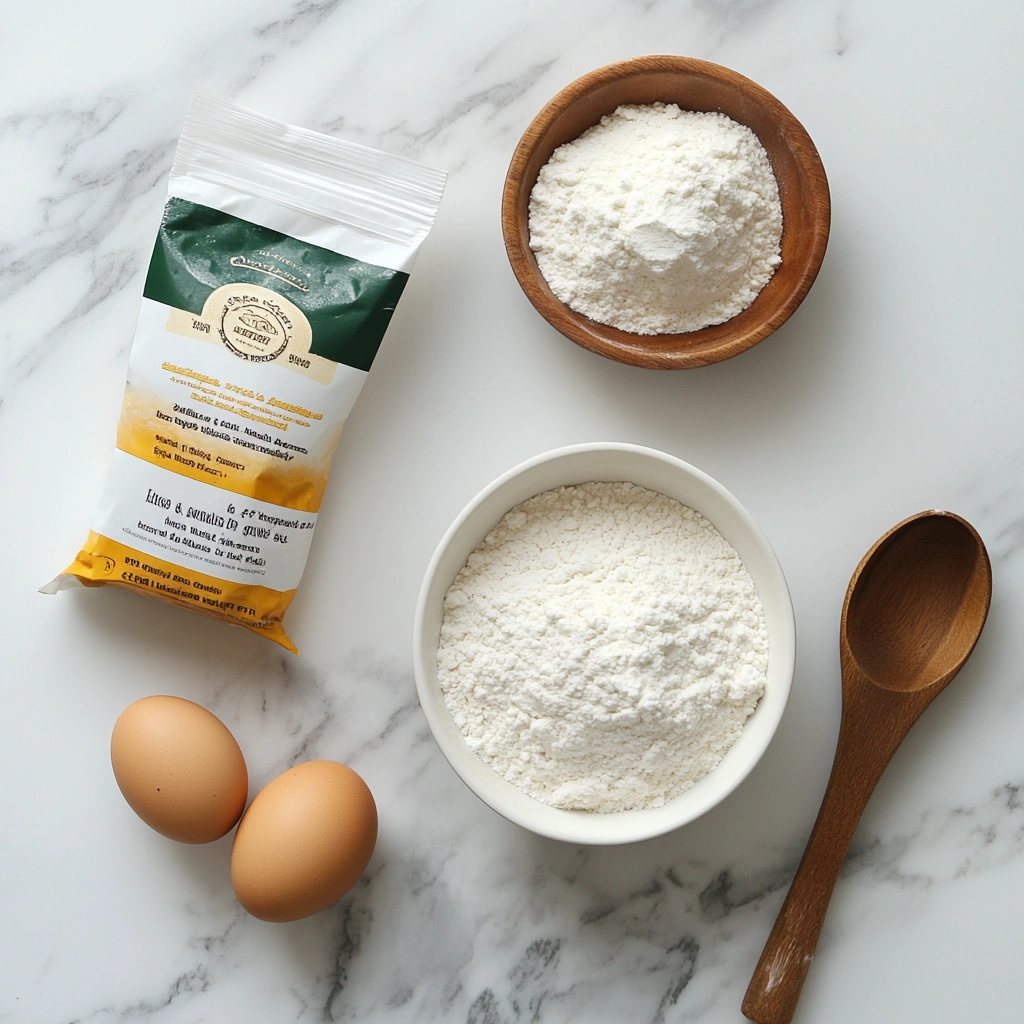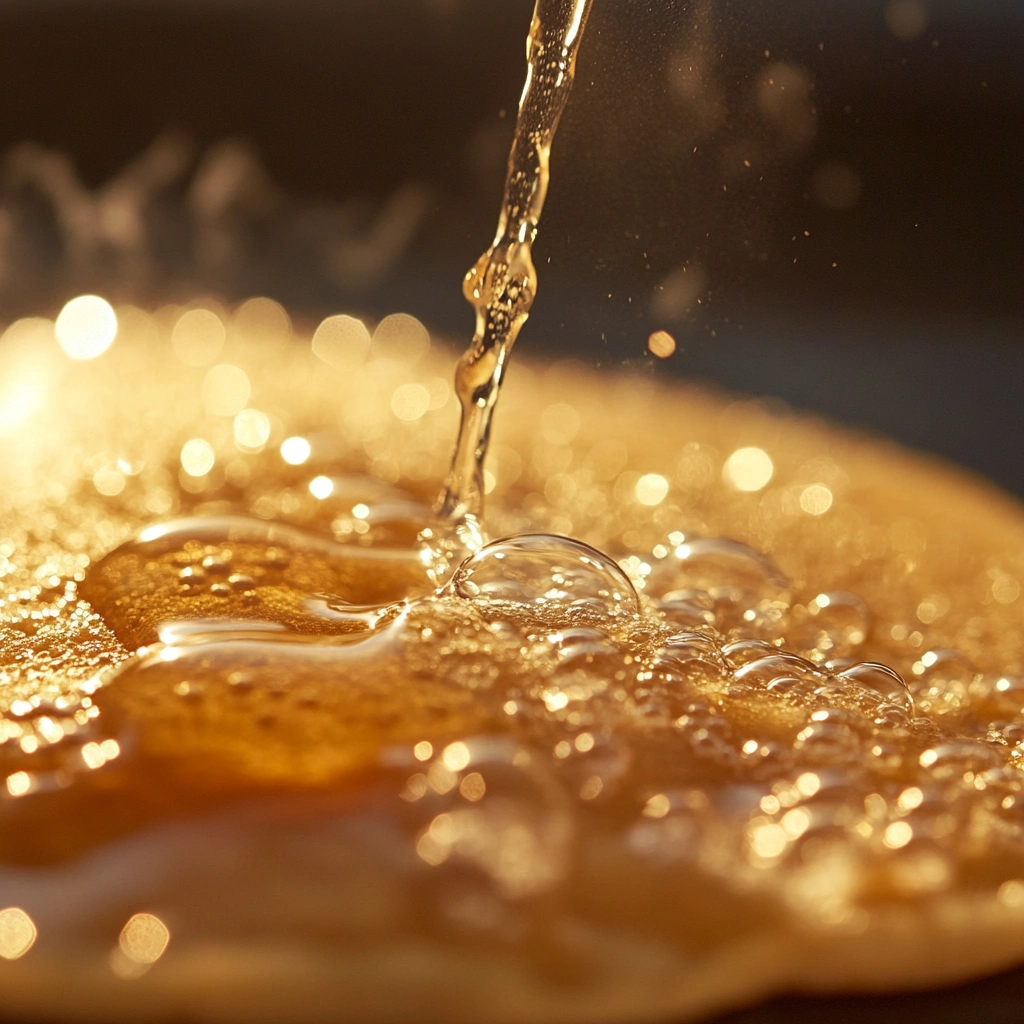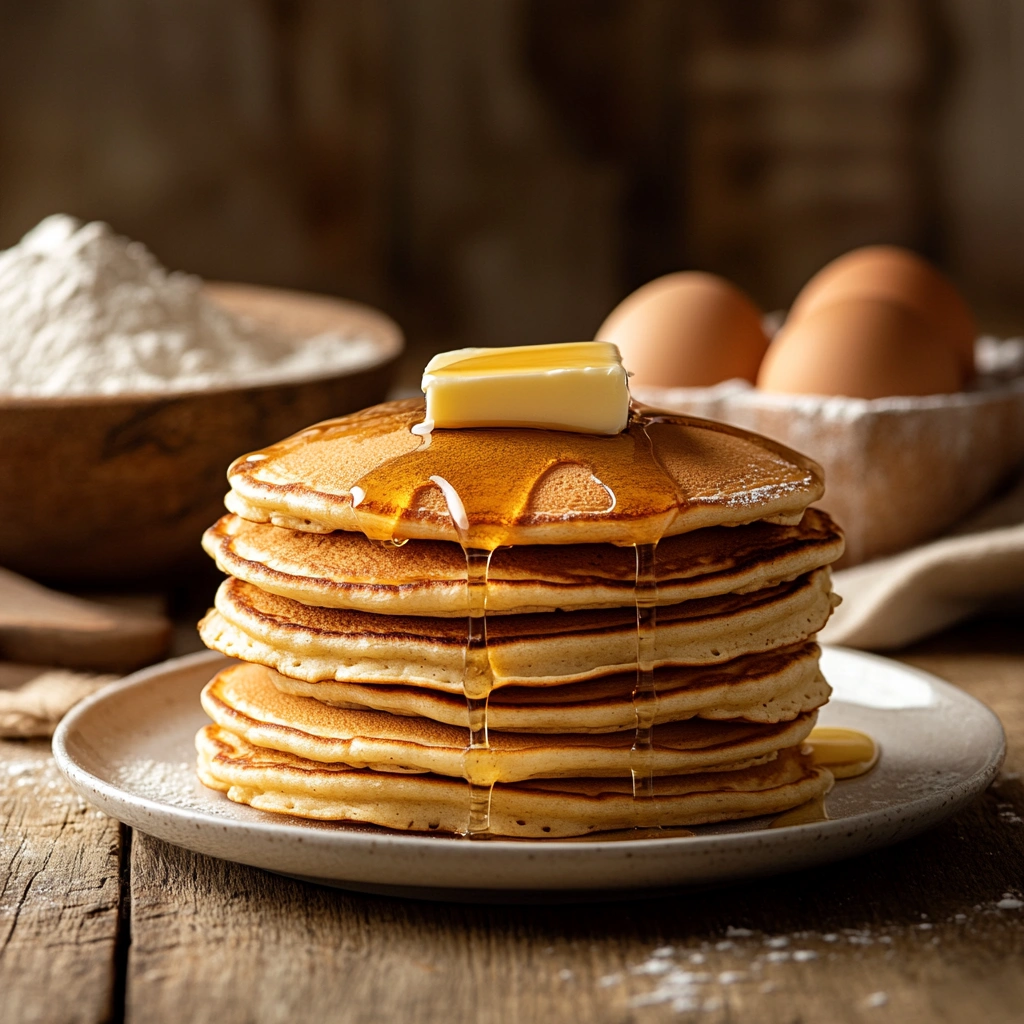What Is Pancake Mix Made Of?
Meta Description: Learn what pancake mix is made of, from flour to flavorings, and how each ingredient contributes to the perfect pancake.
Pancakes are the quintessential breakfast favorite, and a box of pancake mix makes whipping up a batch effortless. But have you ever stopped to wonder, What is pancake mix made of? This article dives into the essential and optional ingredients, revealing how each contributes to those fluffy, golden treats. Let’s uncover the secrets behind the blend that’s brought joy to countless breakfast tables.
Part 1: The Foundation of Pancake Mix
Pancake mix might seem like a simple concoction, but its foundation lies in a careful balance of ingredients. Each component plays a role in creating the ideal batter, ensuring the pancakes turn out light, fluffy, and delicious.
All-Purpose Flour: The Base Ingredient
At the heart of most pancake mixes, all-purpose flour serves as the primary ingredient. Its versatile nature provides structure to the batter, creating that characteristic pancake texture. Rich in starch, flour absorbs the liquid in the recipe, allowing the batter to bind together while offering just enough elasticity to achieve a soft crumb.
Alternative flours, such as whole wheat or oat flour, bring variety to the mix. These options cater to specific dietary needs, like increased fiber or gluten-free preferences, while introducing unique flavors and textures.
Alternative Flours: Whole Wheat, Oat, and Buckwheat
Whole wheat flour adds a nutty flavor and a nutritional boost, thanks to its higher fiber and protein content. Similarly, oat flour—made from finely ground oats—is a fantastic choice for gluten-free eaters, offering a subtly sweet and hearty flavor. For those craving a more rustic, earthy note, buckwheat flour fits the bill perfectly.
Experimenting with these flours allows you to adapt pancake mixes for different tastes and dietary requirements, ensuring there’s something for everyone at the breakfast table.
Part 2: Leavening Agents – Creating Fluffiness
Pancakes are adored for their light and airy texture, and the magic behind this lies in the leavening agents. These unsung heroes work tirelessly to give your pancakes the fluff you love. But how exactly do they work, and what makes them indispensable in pancake mix?

Baking Powder and Baking Soda: How They Work
Leavening agents like baking powder and baking soda are staples in most pancake mixes. They ensure the batter rises beautifully by creating bubbles during the cooking process. Let’s break down how they operate:
- Baking Powder: This is a double-acting leavening agent, meaning it works twice—first when it’s mixed with the wet ingredients, and again when exposed to heat. This two-step reaction provides the batter with its initial lift and sustains the fluffiness as the pancakes cook.
- Baking Soda: Used less frequently on its own, baking soda requires an acidic ingredient (like buttermilk or yogurt) to activate. When combined, it releases carbon dioxide gas, which creates the bubbles that give pancakes their signature rise.
It’s fascinating how these chemical reactions bring pancake batter to life, transforming it from a thick liquid into soft, golden discs. Without them, pancakes would be dense and unappealing.
The Role of Acids in Leavening
Acidic ingredients play a crucial supporting role in the leavening process, especially when baking soda is part of the mix. Buttermilk powder or cream of tartar are common additions in pancake mixes that help activate the leavening agents. Here’s why they’re important:
- Buttermilk Powder: Adds a tangy flavor while balancing the alkalinity of baking soda.
- Vinegar or Lemon Juice: Though not included in most mixes, these can be added to DIY recipes for extra lift.
The balance between acidity and leavening agents is vital; too much or too little can affect the texture, flavor, and rise of the pancakes. That’s why store-bought mixes are meticulously crafted to ensure consistent results.
Other Leavening Options
Though baking powder and soda dominate the pancake mix world, other leavening methods have made their way into the culinary scene:
- Yeast: Rare in traditional pancake mixes but popular for certain regional variations like sourdough pancakes, yeast creates a unique, airy texture and a slightly tangy taste.
- Whipped Egg Whites: While not typically part of pre-packaged pancake mixes, some recipes call for them. Folding whipped egg whites into the batter introduces air, making the pancakes extra fluffy.
Each leavening agent brings its own charm, but together with acids and supporting ingredients, they deliver the irresistible lift that defines pancakes.
Troubleshooting Flat Pancakes
Despite the science behind leavening agents, pancakes can sometimes fall flat—literally. Here are some common causes and solutions:
- Expired Baking Powder or Soda: These lose potency over time. Always check the expiration date or test with a bit of water (for baking powder) or vinegar (for baking soda) to ensure they fizz.
- Overmixing the Batter: While it’s tempting to stir until smooth, overmixing activates the gluten in the flour, leading to dense pancakes. Gently combine ingredients until just mixed, even if a few lumps remain.
- Cooking Temperature Issues: If the skillet is too hot, the exterior cooks faster than the interior, trapping steam and preventing a proper rise. Use medium heat for consistent cooking.
Natural and Gluten-Free Leavening Alternatives
For those seeking natural or gluten-free options, some mixes incorporate unique leavening methods:
- Baking Ammonia (Ammonium Carbonate): Once used widely before baking powder became common, it’s still favored in some old-fashioned recipes for its powerful rising effect and crispness.
- Self-Rising Flours: These include built-in leavening agents, eliminating the need for separate baking powder or soda. They’re a time-saver but less common in custom pancake mixes.
Some gluten-free pancake mixes also use psyllium husk or chia seeds as binders, which trap air pockets and mimic the effects of traditional leavening agents.
Enhancing Leavening Naturally
While store-bought mixes ensure convenience, you can amplify the fluffiness at home by incorporating a few tricks:
- Add sparkling water or club soda to the batter for extra bubbles.
- Let the batter rest for 5–10 minutes before cooking, allowing the leavening agents to activate fully.
- Avoid pressing down on the pancakes with a spatula during cooking, as it deflates the bubbles.
The artistry of pancakes owes much to their leavening agents. Without them, we’d be left with flat, unremarkable griddle cakes instead of the light, fluffy pancakes we adore. Whether you’re using traditional baking powder or experimenting with alternative methods, understanding how these ingredients work ensures you’re always flipping your best batch.
Part 3: Sweeteners in Pancake Mix
Sweeteners in pancake mix are more than just a touch of sweetness—they contribute to the flavor, texture, and even the golden-brown color we associate with perfectly cooked pancakes. From traditional granulated sugar to natural alternatives, the choice of sweeteners can significantly affect the final product.
Granulated Sugar: Standard Sweetness
Granulated sugar is the go-to sweetener in most pancake mixes. Its fine crystals dissolve easily in the batter, evenly distributing sweetness. Beyond flavor, sugar contributes to the Maillard reaction—a chemical process responsible for the enticing golden-brown hue of pancakes as they cook.
Adding sugar also helps retain moisture in the pancakes, preventing them from drying out. However, some pancake mixes opt for minimal sugar, leaving you the option to sweeten your pancakes later with syrups or toppings.
Alternative Sweeteners: Brown Sugar, Honey, and Maple Syrup
For a richer flavor, many pancake mixes include brown sugar. Its molasses content gives pancakes a deeper, caramel-like sweetness and a slightly denser texture. Brown sugar is particularly popular in mixes designed for heartier or spiced pancakes, complementing flavors like cinnamon or nutmeg.
Natural sweeteners like honey and maple syrup are also making their way into pancake mixes, especially those marketed as wholesome or organic. Here’s how they contribute:
- Honey: Adds a subtle floral sweetness while enhancing the batter’s moisture retention. Honey’s antimicrobial properties also give pancake mixes a longer shelf life.
- Maple Syrup: Infuses the batter with a distinct, woodsy sweetness. Although often used as a topping, powdered maple syrup is sometimes added directly to the mix for flavor consistency.
These alternatives are ideal for those looking for more natural options or wanting to explore unique flavor profiles.

Low-Sugar and Sugar-Free Options
Health-conscious consumers often seek low-sugar or sugar-free pancake mixes. To cater to this demand, manufacturers use sweeteners like stevia, monk fruit, or erythritol. These options provide sweetness without the calories, making them suitable for individuals managing their sugar intake.
- Stevia: A natural, plant-derived sweetener that’s significantly sweeter than sugar, meaning only a small amount is needed.
- Monk Fruit: Another natural option, monk fruit has zero calories and no aftertaste, making it a favorite in premium pancake mixes.
- Erythritol: A sugar alcohol that mimics the taste and texture of sugar, it’s often used in combination with other sweeteners for a balanced flavor.
Customizing Sweetness Levels
The beauty of pancake mix lies in its versatility. You can easily adjust the sweetness to suit your taste. Here’s how:
- For a sweeter batter, mix in a tablespoon of sugar, honey, or maple syrup.
- For a subtle sweetness, opt for natural sweeteners like mashed bananas or applesauce.
Impact of Sweeteners on Pancakes
The type and amount of sweetener in the mix influence not only the flavor but also the texture and browning. A mix with more sugar will yield pancakes with a caramelized crust, while low-sugar mixes may result in lighter, less golden pancakes.
Part 4: Enhancing Flavor with Salt and Spices
While sweeteners create a delightful base, salt and spices are the secret ingredients that bring balance and depth to pancake mixes. These small but mighty additions transform ordinary pancakes into irresistible treats, elevating their flavor profile with subtle complexity.
The Importance of Salt in Balancing Flavors
Salt might seem like a minor ingredient, but it plays a crucial role in pancake mixes. Without it, pancakes can taste flat or overly sweet. Here’s how salt works its magic:
- Flavor Enhancer: Salt amplifies the natural flavors of other ingredients, from the mild nuttiness of the flour to the sweetness of sugar. Just a pinch can bring out the richness of the batter.
- Balance Creator: By cutting through the sweetness, salt ensures that pancakes have a well-rounded taste, making each bite more satisfying.
- Texture Improver: Salt also affects the structure of pancakes by tightening the gluten network, which helps them hold their shape.
Most pancake mixes use a small amount of table salt, but specialty mixes might incorporate sea salt or kosher salt for a slightly different flavor profile.
Common Spices: Cinnamon, Nutmeg, and Vanilla
Spices in pancake mix add warmth and aroma, turning a simple breakfast into a memorable experience. Let’s explore the most popular options:
- Cinnamon: The star spice in many pancake mixes, cinnamon adds a sweet, woody flavor that pairs beautifully with syrup and fruit toppings. Its subtle heat also enhances the taste of brown sugar or maple syrup in the batter.
- Nutmeg: A small dash of nutmeg introduces a hint of earthiness and warmth. Often used alongside cinnamon, nutmeg gives pancakes a cozy, spiced flavor that’s especially popular in autumn-inspired recipes.
- Vanilla Powder or Extract: Though technically not a spice, vanilla is a beloved addition to pancake mixes. It adds a creamy, fragrant sweetness that complements every other ingredient.
Optional Flavor Additions
For adventurous palates, some pancake mixes include bold spices like cardamom, ginger, or even a touch of cocoa powder. These additions cater to those seeking unique flavor experiences, such as chai-spiced or chocolate pancakes.
Frequently Asked Questions (FAQs)
What are the main ingredients in pancake mix?
The main ingredients in pancake mix typically include all-purpose flour, baking powder, sugar, and salt. Some mixes also include milk powder, oils, or flavorings like vanilla or cinnamon.
Can I make pancakes without eggs?
Yes, pancakes can be made without eggs. You can use substitutes like flaxseed meal, chia seeds, applesauce, or mashed bananas. These alternatives work as binders and provide moisture, ensuring your pancakes hold together.
What can I use instead of milk in pancake mix?
If you’re out of milk, alternatives like almond milk, soy milk, oat milk, or even water can be used in pancake batter. Buttermilk or coconut milk are excellent options for added richness and flavor.
Why are my pancakes flat and dense?
Flat or dense pancakes may result from expired leavening agents, overmixing the batter, or using too much liquid. To fix this, ensure your baking powder or soda is fresh, gently mix the batter, and measure ingredients accurately.
Can I add fruit to pancake batter?
Absolutely! Fresh or dried fruits like blueberries, bananas, or raisins can be mixed into the batter for added flavor and texture. Be sure to chop larger fruits into small pieces to ensure even cooking.
Is pancake mix the same as waffle mix?
Not exactly. While similar, waffle mix often contains more sugar and fat, which creates a crispier texture. Pancake batter is lighter and fluffier, making it perfect for soft, tender pancakes.
Conclusion
Pancake mix is more than a convenient kitchen staple; it’s a carefully crafted blend of ingredients designed to deliver consistent, delicious results every time. From the foundational role of flour to the magic of leavening agents, the sweetness of sugar, and the subtle enhancements of salt and spices, each component plays a vital part in creating those golden stacks we all love.

